Differential involvement of excitatory and inhibitory neurons of cat motor cortex in coincident spike activity related to behavioral context
- PMID: 20534853
- PMCID: PMC6632689
- DOI: 10.1523/JNEUROSCI.0770-10.2010
Differential involvement of excitatory and inhibitory neurons of cat motor cortex in coincident spike activity related to behavioral context
Abstract
To assess temporal associations in spike activity between pairs of neurons in the primary motor cortex (MI) related to different behaviors, we compared the incidence of coincident spiking activity of task-related (TR) and non-task-related (NTR) neurons during a skilled motor task and sitting quietly in adult cats (Felis domestica). Chronically implanted microwires were used to record spike activity of MI neurons in four animals (two male and two female) trained to perform a skilled reaching task or sit quietly. Neurons were identified as TR if spike activity was modulated during the task (and NTR if not). Based on spike characteristics, they were also classified as either regular-spiking (RS, putatively excitatory) or fast-spiking (FS, putatively inhibitory) neurons. Temporal associations in the activities of simultaneously recorded neurons were evaluated using shuffle-corrected cross-correlograms. Pairs of NTR and TR neurons showed associations in their firing patterns over wide areas of MI (representing forelimb and hindlimb movements) during quiet sitting, more commonly involving RS neurons. During skilled task performance, however, significantly coincident firing was seen almost exclusively between TR neurons in a smaller part of MI (representing forelimb movements), involving mainly FS neurons. The findings of this study show evidence for widespread interactions in MI when the animal sits quietly, which changes to a more specific and restricted pattern of interactions during task performance. Different populations of excitatory and inhibitory neurons appear to be synchronized during skilled movement and quiet sitting.
Figures

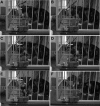
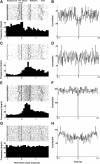
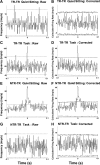

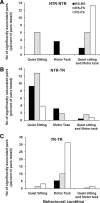
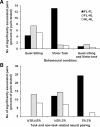
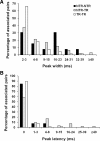
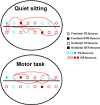
Similar articles
-
Motor cortical networks for skilled movements have dynamic properties that are related to accurate reaching.Neural Plast. 2011;2011:413543. doi: 10.1155/2011/413543. Epub 2011 Oct 9. Neural Plast. 2011. PMID: 22007332 Free PMC article.
-
Patterns of spatio-temporal correlations in the neural activity of the cat motor cortex during trained forelimb movements.Somatosens Mot Res. 2009 Jun;26(2):31-49. doi: 10.1080/08990220903098308. Somatosens Mot Res. 2009. PMID: 19697261
-
Neural integration of reaching and posture: interhemispheric spike correlations in cat motor cortex.Exp Brain Res. 2010 May;202(4):765-77. doi: 10.1007/s00221-010-2180-z. Epub 2010 Feb 18. Exp Brain Res. 2010. PMID: 20165839
-
Neural dynamics and information representation in microcircuits of motor cortex.Front Neural Circuits. 2013 May 3;7:85. doi: 10.3389/fncir.2013.00085. eCollection 2013. Front Neural Circuits. 2013. PMID: 23653596 Free PMC article. Review.
-
Skilled forelimb movements and internal copy motor circuits.Curr Opin Neurobiol. 2015 Aug;33:16-24. doi: 10.1016/j.conb.2014.12.009. Epub 2015 Jan 10. Curr Opin Neurobiol. 2015. PMID: 25588912 Free PMC article. Review.
Cited by
-
Oscillation-induced signal transmission and gating in neural circuits.PLoS Comput Biol. 2014 Dec 11;10(12):e1003940. doi: 10.1371/journal.pcbi.1003940. eCollection 2014 Dec. PLoS Comput Biol. 2014. PMID: 25503492 Free PMC article.
-
Motor cortical networks for skilled movements have dynamic properties that are related to accurate reaching.Neural Plast. 2011;2011:413543. doi: 10.1155/2011/413543. Epub 2011 Oct 9. Neural Plast. 2011. PMID: 22007332 Free PMC article.
-
A spiking neural network model of spatial and visual mental imagery.Cogn Neurodyn. 2020 Apr;14(2):239-251. doi: 10.1007/s11571-019-09566-5. Epub 2019 Dec 5. Cogn Neurodyn. 2020. PMID: 32226565 Free PMC article.
-
Excitatory and inhibitory STDP jointly tune feedforward neural circuits to selectively propagate correlated spiking activity.Front Comput Neurosci. 2014 May 7;8:53. doi: 10.3389/fncom.2014.00053. eCollection 2014. Front Comput Neurosci. 2014. PMID: 24847242 Free PMC article.
-
Toward Building Hybrid Biological/in silico Neural Networks for Motor Neuroprosthetic Control.Front Neurorobot. 2015 Aug 11;9:8. doi: 10.3389/fnbot.2015.00008. eCollection 2015. Front Neurorobot. 2015. PMID: 26321943 Free PMC article.
References
-
- Allum JH, Hepp-Reymond M-C, Gysin R. Cross-correlation analysis of interneuronal connectivity in the motor cortex of the monkey. Brain Res. 1982;231:325–334. - PubMed
-
- Baker SN, Spinks R, Jackson A, Lemon RN. Synchronization in monkey motor cortex during a precision grip task. I. Task dependant modulation in single unit synchrony. J Neurophysiol. 2001;85:869–885. - PubMed
-
- Baranyi A, Szente MB, Woody CD. Electrophysiological characterization of different types of neurons recorded in vivo in the motor cortex of the cat. I. Patterns of firing activity and synaptic responses. J Neurophysiol. 1993;69:1850–1864. - PubMed
-
- Biswal B, Yetkin FZ, Haughton VM, Hyde JS. Functional connectivity in the motor cortex of resting human brain using echo-planar MRI. Magn Reson Med. 1995;34:537–541. - PubMed
Publication types
MeSH terms
Grants and funding
LinkOut - more resources
Full Text Sources
Miscellaneous
